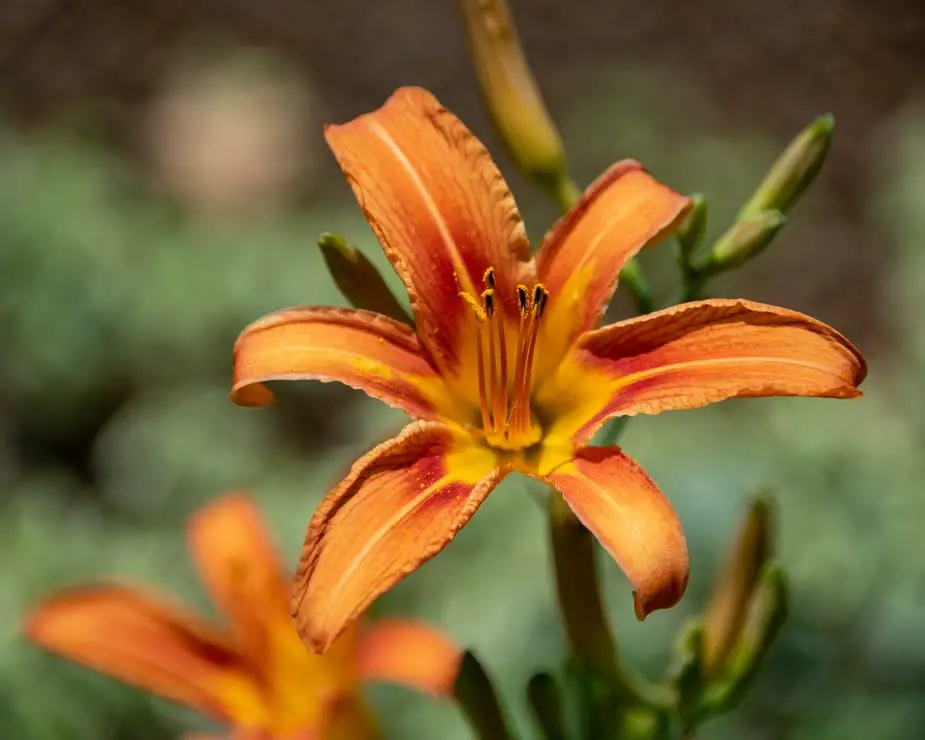
The herbaceous perennials Tiger lilies that give rise to stately flowers in summer, are native to China, Korea and Japan. Lilium lancifolium or Lilium tigrinum, as they are officially known, are now grown in many parts of the world and are renowned for their beauty. Though they are indigenous to Asia, these flowers can be grown in USDA planting zones 3 to 9.
The well-known Swedish botanist Carl von Linne (Linnaeus) was the first to describe the Tiger Lily in 1753. Though they are native wildflowers in certain parts of Asia, they have become naturalized and are found across the United States and New England. The bulbs grow back every year and, may even form clumps, without the need for too much gardening skills.
The bulbs of these plants may be planted in spring or fall, which means that the summer will bring in the eclectic blooms. A remarkable feature of these flowers is that the petals fold back and there are dark spots on them, highlighting the pretty colors of the flowers.
The sight of these flowers on the border hedges is especially attractive, as the continuous array of these mesmerizing flowers is a visual treat. They are seldom grown as individual plants. They are one of the most sought-after varieties of lilies and are a garden favorite. The hairy stems of these flowers and the presence of 6 stamens in each flower add to the descriptive beauty. Though they are not fragrant like the other varieties of lilies, their unique spots earn them a well deserving spot in the list of exquisite flowers.
Interesting facts about Tiger Lilies
Lilies hold a special charm and many different cultures have embraced the beauty of lilies, depending upon their size, color and other unique characteristics. For example, white lilies are commonly used in funerals.
The Tiger lilies, however, are orange in color. A color that symbolizes energy, enthusiasm and balance in different cultures. It has always been symbolized for prosperity, which could be due to the distinct black spots. When gifted, it is considered to bring luck for the receiver and is a highly valued gift.
The Tiger lilies also have pride of place in the Victorian culture. Apart from affluence that this lily is associated with, Tiger lilies are considered to be a symbol of pride. They were once associated with nobility, without the connotation of vanity.
Buddhism too has its own interpretations for these exquisite lilies. They symbolize mercy and compassion, and certain aggressive female characteristics.
Physical attributes of tiger lilies
1) Though they look delicate, they are tolerant to heat and quite hardy. They will continue to grow in height every year, with a greater number of flowers produced every time.
2) They grow fast and will reach a height of 1.5m quickly
3) These perennials bloom every summer and, similar to other varieties of the lilies, they grow from scaly bulbs.
4) Each plant can give rise to nearly 40 blooms
5) The bulblets are present on the axis of the leaves.
Interesting facts about Display of Tiger Lilies
1) The Tiger lilies are an excellent border for every house, as they form a rich display of color and blooms.
2) These flowers can also be grown in the garden in pots, adding interest to certain sections.
3) The beautiful flowers are often used by florists for display and in bouquets. When placed in a vase, they last for nearly 2 weeks.
Interesting Facts about Growing Tiger Lilies
1) The Tiger Lilies should be planted in well-drained soil during spring.
2) Old Stems should be removed before plants, to avoid disease.
3) When growing Tiger lilies, it should be kept in mind that they could carry a lot of viral diseases like the lily mosaic virus. Such diseases could easily spread to other plants in the garden and so, care should be taken to prevent such incidences.
4) The bulbs are commonly used for planting, but they can also be grown from seeds. They should be first isolated from other lilies and grown in wet soil. Since these are wildflowers, they are easy to grow. They are herbaceous perennials that will add an interesting appeal to your garden with their vivid colors.
5) The vital step in effective planting is to ensure that they are planted in soil with good drainage. If there is water logging, the bulbs may not survive and may even rot.
6) Once the root system of these Tiger lilies matures in the soil, they will grow without the need for active support or care. They are known to even tolerate certain periods of drought and are hands-off plants.
7) Tiger lilies, like many other flowering plants, grow well in sunny regions. Though they are not as difficult to grow as some of the other flowering plants, they need at least partial sunlight to grow well. In fact, protecting them from harsh sunlight prevalent during afternoon may help.

8) Ensure that the soli are enhanced with humus or compost before planting the bulbs. Other sources of amendment to the soil include straw, peat moss and good sand. These will help in retaining the right amount of moisture while draining out the excess. These lilies grow in any type of soil, but flourish in fertile soil.
9) The need for water is just like any other average flowering plant. Though they can withstand a bit of drought as they grow in the wild, they require watering at regular intervals. Rainfall received at regular periods may be sufficient to support the growth of these lilies. It may be necessary to water the plants if the soil is parched and devoid of any moisture.
10) The best period of growth for these lilies is during spring, as they grow dormant during winter and fall.
11) During the harsh winter, adding mulch to the soil above will help protect the bulbs from the freezing climate. They can also tolerate high humidity, though they don’t need it to grow.
12) There is not a lot of fertilizer that is required by these lilies for growth. Adding a bit of compost to the soil about every 6 months should do. This will help in enhancing the nutrition of the soil and encourage flowering.
13) If you notice that your Tiger lilies are not giving rise to a lot of flowers , you may have to shift them to a bigger pot or enhance the soil with fertilizers. Use a lot of organic matter to enrich the soil.
14) These lilies grow in abundance and could take over sections of your garden. You can also actively increase their numbers by planting the bulbils, during spring.
15) Another method of propagation is through bulb division. This requires removing the bulbs from the soil with the utmost care and separating the bulbs. These can be replanted, ensuring that they are pointed upward.
Interesting facts about the Flowers
1) The Tiger Lilies are a part of the Japanese cuisine, as the bulbs taste like potatoes. The pollen, however, are said to be poisonous.
2) Cats should never consume these lilies, though they are eaten by humans. It could lead to lethargy, vomiting and death.
3) These lilies are found in ditches in the wild and are known as ditch lilies.
4) The flowers are said to bring in wealth and prosperity and are cherished for these associations.
5) Another superstition about these lilies is that smelling them could bring in freckles.
6) There are 5 species of Tiger lilies
7) The Tiger lilies are also known to have medicinal properties, known to relieve nasal congestion and nausea
8) The flowers look like the animal that they are named after- tigers. They are a unique orange in color and have black spots. The only difference in the animal is that it has stripes instead of spots.
9) The flowers usually bloom during early summer, but they may also do so in the middle of summer.
10) Their unique appearance is accentuated by the folded petals that resemble a star or even a Turk’s cap.
11) Many lilies are also associated with protection. Tiger lilies are associated with warding off evil spirits, which is why they are grown in gardens or hung on doors. Apart from evil spirits, they are also known to ward off ghosts.
Tiger lilies are sought after for their unique appearance and for the numerous myths that surround their presence. From Eastern cultures to Western culture, they hold a very important status. This ensures their use in most bouquets and decorations in royal houses across the world. Considered to be harbingers of prosperity, they are cherished n the garden and propagated with abandon. Gifting these beautiful flowers is also considered to bring good luck, which is why they are present at most weddings and important functions. Their tiger-like appearance has truly made them valuable and lent a surreal appeal.
